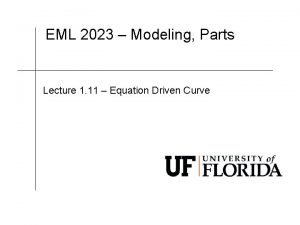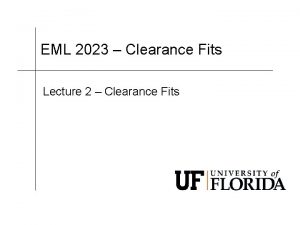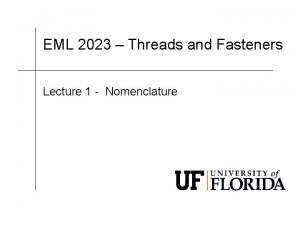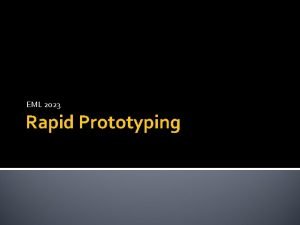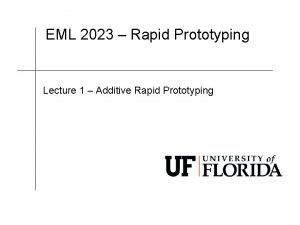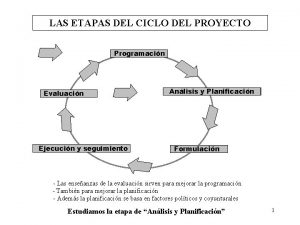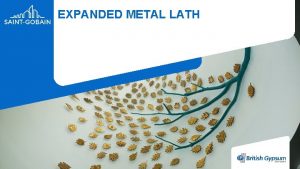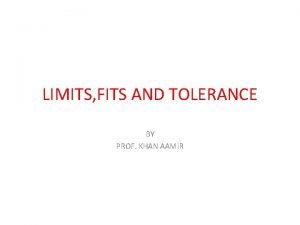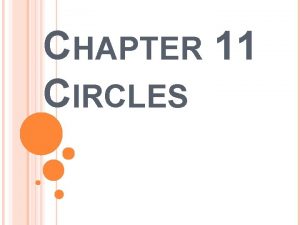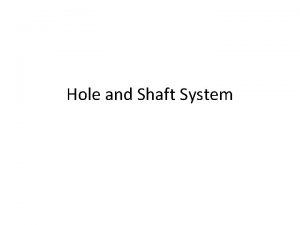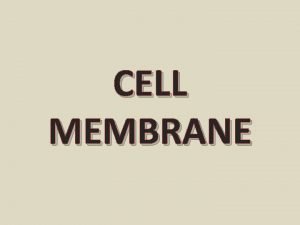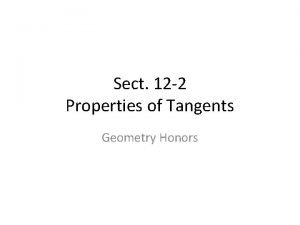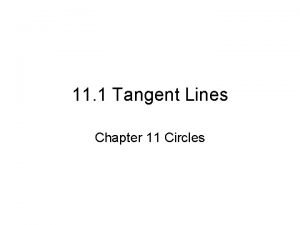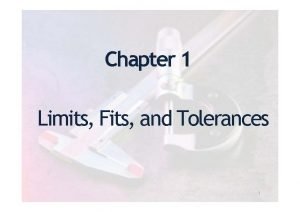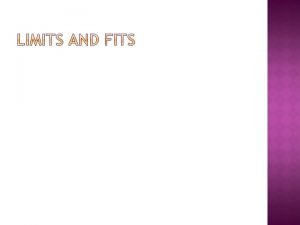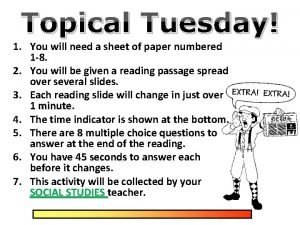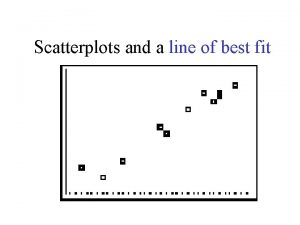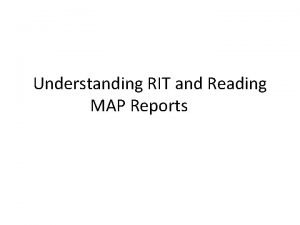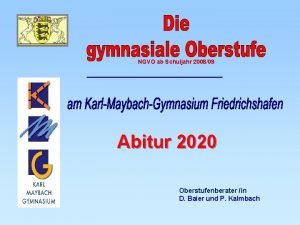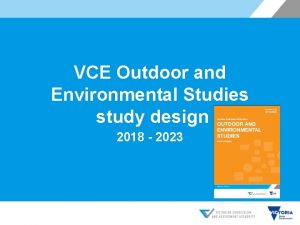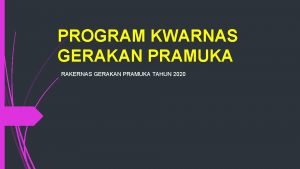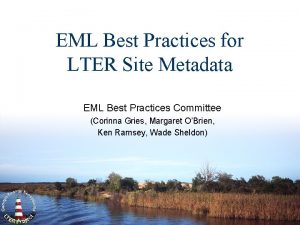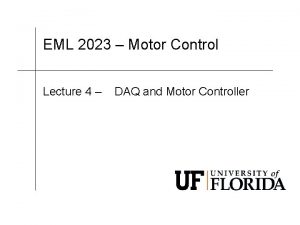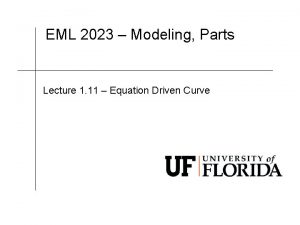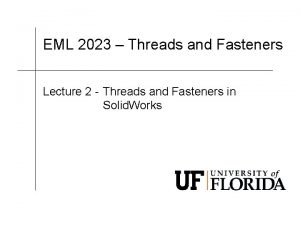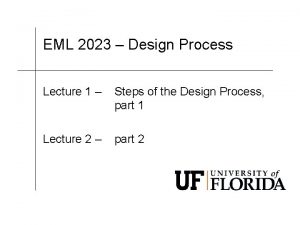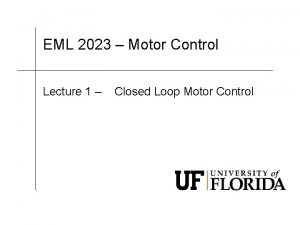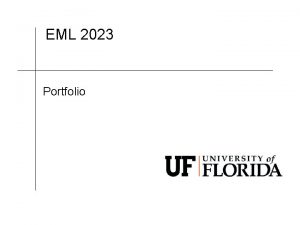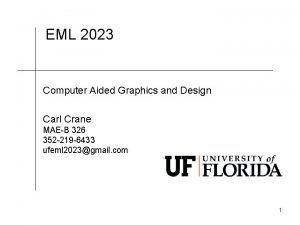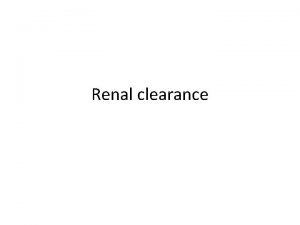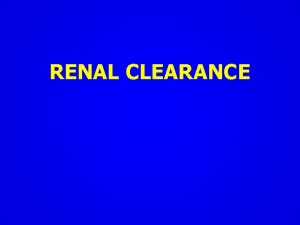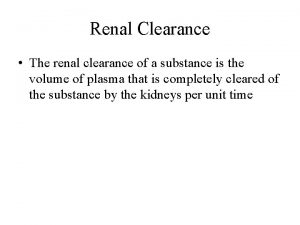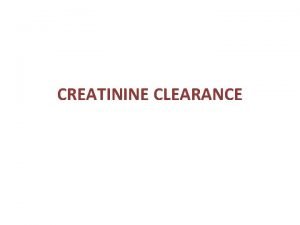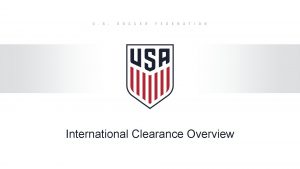EML 2023 Clearance Fits Lecture 2 Clearance Fits


































- Slides: 34

EML 2023 – Clearance Fits Lecture 2 – Clearance Fits

Cylindrical Fits EML 2023 Computer Aided Design 2

Cylindrical Fits – English Units EML 2023 Computer Aided Design 3

Cylindrical Fits – English Units EML 2023 Computer Aided Design 4

Cylindrical Fits – English Units EML 2023 Computer Aided Design 5

Cylindrical Fits – English Units EML 2023 Computer Aided Design 6

Cylindrical Fits – English Units tolerance - difference between the limits of size for a single feature ; shaft. 0025 ; hole. 0040 limits of tolerance – the max and min sizes of a single feature allowance – the tightest fit between two mating parts ; . 0050 nominal size – the general size of a shaft or hole ; 1. 5 basic size – the size to which the plus-and minus is applied actual size – the measured size of the finished part fit - the degree of tightness or looseness between two assembled parts EML 2023 Computer Aided Design 7

Cylindrical Fits – English Units • clearance fit – gives a clearance between two assembled mated parts ; • min clearance. 005 ; • max clearance. 0115 • transition fit • interference fit • line fit EML 2023 Computer Aided Design 8

Cylindrical Fits – English Units • clearance fit • interference fit – a binding fit that requires the parts to be forced together, much as if they were welded • transition fit – may range from a interference fit to a clearance fit between the mated parts • line fit – results in surface contact or clearance when limits are reached EML 2023 Computer Aided Design 9

Cylindrical Fits – English Units • The ANSI B 4. 1 standard defines a series of fits between cylindrical features in inches for the basic hole system. • The types of fits covered in the standard are: – – – RC: running or sliding clearance fits LC: clearance locational fits LT: transition locational fits LN: interference locational fits FN: force and shrink fits EML 2023 Computer Aided Design 10

Cylindrical Fits – English Units • RC: running or sliding clearance fits – RC 1 to RC 9 • LC: clearance locational fits • LC 1 to LC 11 • LT: transition locational fits • LT 1 to LT 6 • LN: interference locational fits • LN 1 to LN 3 • FN: force and shrink fits • FN 1 to FN 5 EML 2023 Computer Aided Design 11

Example – RC 9 Fit • hole and shaft have a basic diameter of 2. 5” • From Tables in Appendix 29 thousands of an inch EML 2023 Computer Aided Design 12

Example – LT 3 Fit • hole and shaft have a basic diameter of 2. 5” • From Tables in Appendix 31 2. 5012 2. 5000 2. 5008 2. 5001 thousands of an inch EML 2023 Computer Aided Design 13

Example – LN 2 Fit • hole and shaft have a basic diameter of 2. 5” • From Tables in Appendix 32 2. 5012 2. 5000 2. 5021 2. 5014 thousands of an inch EML 2023 Computer Aided Design 14

Example Problem 15

Cylindrical Fits – Metric Units • ANSI B 4. 2 standard • basic size – the diameter from which limits are calculated • upper and lower deviation – the difference between the hole or shaft size and the basic size • tolerance - the difference between the maximum and minimum sizes EML 2023 Computer Aided Design 16

Cylindrical Fits – Metric Units EML 2023 Computer Aided Design 17

Cylindrical Fits – Metric Units • fundamental deviation – a letter grade that describes the deviation closest to the basic size • International Tolerance (IT) grade – a series of tolerances that vary with the basic size to provide a uniform level of accuracy within a given grade • there are 18 IT grades: IT 01, IT 0, IT 1, …, IT 16 EML 2023 Computer Aided Design 18

Cylindrical Fits – Metric Units • Hole basis – a system of fits based on the minimum hole size as the basic diameter – the fundamental deviation for a hole-basis system is “H” – Appendices 35 and 36 give hole-basis data for tolerances • Shaft basis – a system of fits based on the maximum shaft size as the basic diameter – the fundamental deviation for a hole-basis system is “h” – Appendices 37 and 38 give shaft-basis data for tolerances EML 2023 Computer Aided Design 19

20

Cylindrical Fits – Metric Units EML 2023 Computer Aided Design 21

Cylindrical Fits – Metric Units EML 2023 Computer Aided Design 22

Example 1 • determine the shaft and hole limits for: – – hole-basis system a close running fit a basic diameter of 49 mm use a preferred size EML 2023 Computer Aided Design 23

24

Example 1 • use a preferred basic diameter of 50 mm • use a fit of H 8/f 7 EML 2023 Computer Aided Design 25

Example 2 • determine the shaft and hole limits for: – – hole-basis system a location transition fit a basic diameter of 57 mm use a preferred size EML 2023 Computer Aided Design 26

EML 2023 Computer Aided Design 27

Example 2 • use a preferred basic diameter of 60 mm • use a fit of H 7/k 6 EML 2023 Computer Aided Design 28

Example 3 • determine the shaft and hole limits for: – – hole-basis system a medium drive fit a basic diameter of 96 mm use a preferred size EML 2023 Computer Aided Design 29

30

Example 3 • use a preferred basic diameter of 100 mm • use a fit of H 7/s 6 EML 2023 Computer Aided Design 31

Nonstandard Fits, Nonpreferred Sizes • determine the shaft and hole limits for: – hole-basis system – a close running fit – a basic diameter of 45 mm (do not change to a preferred size) EML 2023 Computer Aided Design 32

33

Nonstandard Fits, Nonpreferred Sizes • use a fit of H 8/f 7 EML 2023 Computer Aided Design 34
 Eml2023
Eml2023 Eml 2023
Eml 2023 Eml 2023
Eml 2023 Eml2023
Eml2023 Uf eml 2023
Uf eml 2023 Limits fits and tolerances
Limits fits and tolerances Limits fits and tolerances lecture notes
Limits fits and tolerances lecture notes 01:640:244 lecture notes - lecture 15: plat, idah, farad
01:640:244 lecture notes - lecture 15: plat, idah, farad Predictive maintenance wikipedia
Predictive maintenance wikipedia Ciclo del proyecto bajo el eml
Ciclo del proyecto bajo el eml Lath
Lath Strange fits of passion have i known summary
Strange fits of passion have i known summary 50h7 tolerance
50h7 tolerance A belt fits tightly around two pulleys
A belt fits tightly around two pulleys Inductive analytical approach to learning
Inductive analytical approach to learning Security that fits everywhere
Security that fits everywhere Fits types
Fits types Most common blood type in europe
Most common blood type in europe A belt fits tightly around two pulleys
A belt fits tightly around two pulleys Find the value of
Find the value of Fits and tolerance شرح
Fits and tolerance شرح Types of tolerance
Types of tolerance Two signal words on whmis 2015
Two signal words on whmis 2015 Which fits best in the empty box above?
Which fits best in the empty box above? The equation y=12.21x+37.42 fits the scatter plot
The equation y=12.21x+37.42 fits the scatter plot Judicial restraint clipart
Judicial restraint clipart One size fits all
One size fits all Abitur 2023 bw kurswahl
Abitur 2023 bw kurswahl Johns hopkins medicine strategic plan
Johns hopkins medicine strategic plan Facherlass abitur 2021 bw
Facherlass abitur 2021 bw Heaolu arengukava 2016-2023
Heaolu arengukava 2016-2023 Aecp program army
Aecp program army Vce outdoor and environmental studies
Vce outdoor and environmental studies Raimuna nasional 2023
Raimuna nasional 2023 Horizon 2023
Horizon 2023
